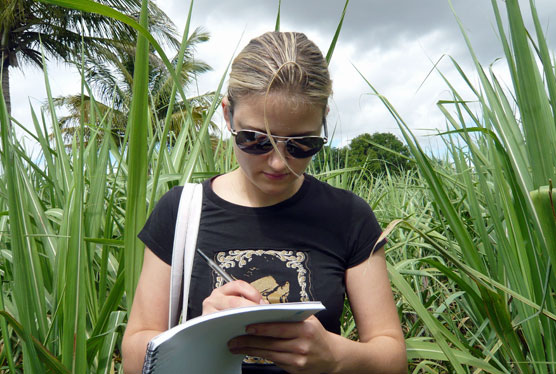Press release 2015-02-10 at 14:53
SYKE's press release

Researcher Aura Nousiainen working in Aurangabad India (2009). Photo: Kirsten Jørgensen
The addition of carbon, which is required as a nutrient by the microorganisms in soil and groundwater, was found to be the most promising remediation method in the remediation of soil and groundwater contaminated with the pesticide atrazine. This conclusion is reached in Aura Nousiainen’s doctoral dissertation, which will be presented for public examination at the University of Helsinki on Friday 13 February 2015. There is a demand for the remediation method, as atrazine is the most common pollutant found in groundwater in Finland. The substance in question is still commonly used outside Europe.
The study compared four bioremediation methods that were used for reducing the amount of atrazine in soil or groundwater. Factors that must be taken into consideration when choosing the most suitable bioremediation method include land use, the geographic origin of the soil, treatment history and the amount of organic matter.
The degradation of atrazine was enhanced by the addition of decomposer microorganisms or the nutrients they need, i.e. carbon, to the soil. Adding carbon in particular to Finnish subsoil, which is poor in carbon, contributed to the degradation of low concentrations of atrazine as well.
The most common pesticide found in groundwater in Finland despite its use being discontinued
Atrazine has been one of the most important herbicides for fifty years. In Finland, the use of atrazine was discontinued approximately 25 years ago. Regardless of this, it continues to be the most common pesticide found in groundwater in Finland. Atrazine, which has also been studied as an endocrine disruptor, was found in 26% of groundwater samples studied in 2002–2005. The EU banned its use in 2004.
Need for effective remediation methods
There is a need for effective remediation methods, as a large part of the contaminated groundwater is situated in water catchment areas. Some groundwater intakes have even been closed due to atrazine. Atrazine is removed at activated carbon filter plants, for example, but they are expensive to build and maintain.
The degradation of atrazine was compared in Finland and India from 2009 to 2014
The study was conducted in close collaboration with the National Environmental Engineering Research Institute (NEERI), the Finnish Environment Institute’s partner in India. This collaboration made it possible to compare tropical farmland in active agriculture with the subsoil of northern coniferous forests that was contaminated twenty years ago through contact with groundwater. In India, atrazine continues to be used widely as a herbicide.
More information
Researcher Aura Nousiainen, Finnish Environment Institute SYKE, tel. +358 295 251 463, firstname.lastname@ymparisto.fi
Communication specialist Katri Haatainen, Finnish Environment Institute SYKE, tel. +358 295 251 135, firstname.lastname@ymparisto.fi
Links:
Doctoral dissertation: Application of genomic tools in bioremediation of atrazine contaminated soil and groundwater
Photo for media: Tutkija Aura Nousiainen ottamassa näytettä sokeriruokoviljelmällä Aurangabadissa Intiassa v. 2009. Kuva: Kirsten Jørgensen (jpg 3.5 Mb)
Project: Genomic tools in bioremediation: A case study with atrazine as pollutant (GENOTOOLS) (SYKE)